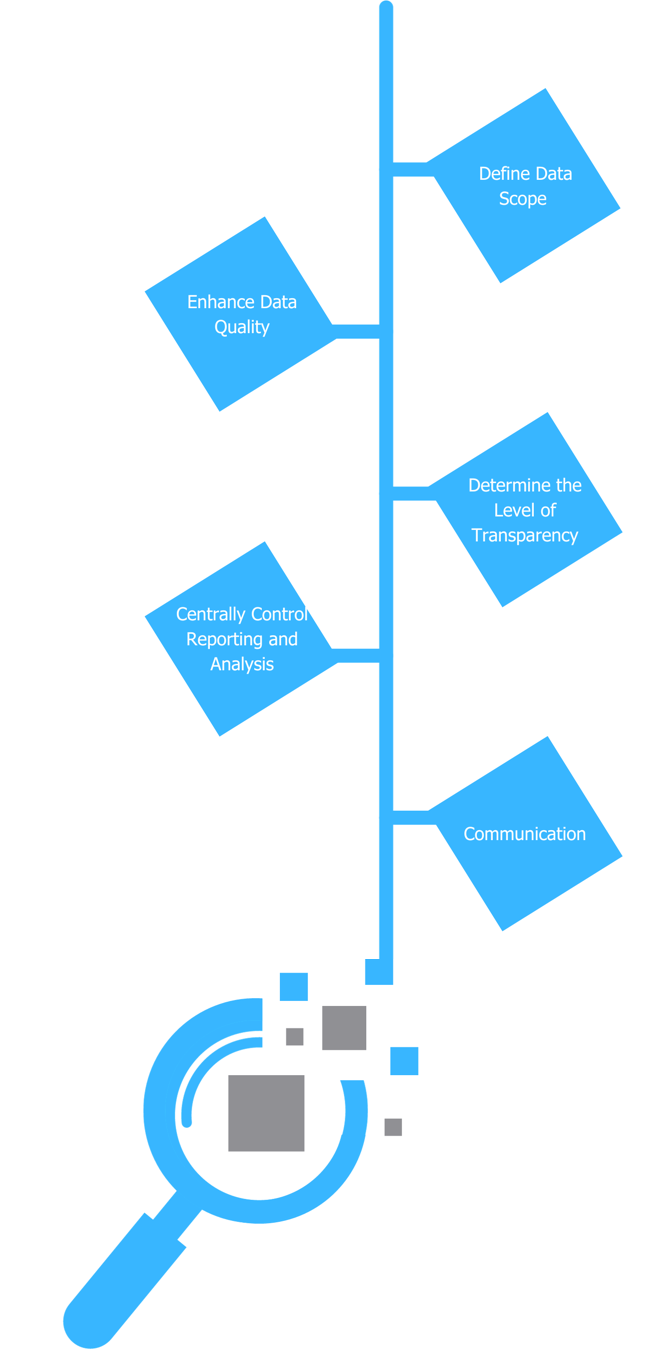Existing customer? Login
Blog
October 12th, 2023
The 5 levels of transparency - how to get more transparency in your procurement
 Rubina Hatziparassidis
Rubina Hatziparassidis
The topic of "transparency in procurement" is a recurring theme in many companies and studies. However, what complicates matters is that each procurement manager has a different understanding of what it entails. Most of these managers wonder how to achieve the desired transparency in the first place. Furthermore, defining "transparency in procurement" for their own company often gets overlooked.
Only a few procurement managers fully embrace the concept and do not limit transparency to just poor data quality. In fact, it encompasses much more than inadequately maintained system data.
However, there isn't a uniform definition of "transparency in procurement".
We, from SCALUE, have taken it upon ourselves to share our knowledge, summarizing the key insights from customer conversations over the years and categorizing them into five levels of transparency.

First Level of Transparency: Define Data Scope
Many medium-sized and large enterprises use at least one or even multiple inventory management systems. Over time, these systems have been heavily customized, resulting in drastically different data structures. Data becomes increasingly nested, making it challenging to retrieve critical information through standard queries. Many essential details get buried in the system and remain undiscovered. If this situation applies to your company, it's about time to seek assistance from your overburdened IT department. Generally, the further you deviate from a standard inventory management system's settings, the more comprehensive and complex it becomes to represent the entire context.
Moreover, buyers utilize additional supporting data sources such as LME, EUWID, or KIWeb index values. However, the relevance of these indices for specific suppliers or items and the degree to which index developments affect them are often undefined. In our projects, we create an overview of all essential and desired data sources right at the project's outset Our ERP specialists are familiar with the specifics of ERP systems and take your evaluation requirements into account during data extraction. This approach establishes a unified data source, allowing us to produce later-generated evaluations in a reproducible and traceable manner, following our "Single Point of Source" approach.
Second Level of Transparency: Enhance Data Quality
Data quality's significance often remains underrated in many companies, even though they know about it as the foundation for a healthy and transparent procurement department. Often, there's a lack of time and resources, despite a fundamental willingness. In larger companies, separate data maintenance departments are created. The following areas are substantially affected:
- Inconsistent master data: Systematically correct supplier and item duplicates
- Inadequate and inconsistent classification of procurement volumes
- Limited informativeness of order and invoice texts, especially in the indirect sector
We identify the cause directly and collaborate with your IT department to compile a list of individuals with writing permissions in an ERP system. Frequently, we discover that too many people can create and manipulate master data. Simply by narrowing down these groups of individuals, data quality degradation is significantly minimized. Simultaneously, our software systematically improves data quality, saving our customers substantial manual effort. For instance, the aforementioned supplier and item duplicates are largely automated and cleansed with additional data.
Third Level of Transparency: Determine the Level of Transparency
Many companies desire more transparency but only to a limited extent. They implement a multi-tiered roles and rights system, restricting the visibility of procurement volumes to selected individuals or business units. For example, the procurement volume from Germany may not be visible to other country subsidiaries or purchasing groups. With our flexible roles and rights system, companies can determine the level of transparency themselves. However, procurement managers who do away with such barriers tend to perform exceptionally well. For example, planned tenders identified price or quantity synergies across countries more swiftly.
Would you like to learn more about how SCALUE's solution can help optimize your procurement?
Fourth Level of Transparency: Centrally Control Reporting and Analysis
Many procurement departments generate numerous reports daily for management and conduct various analyses. Often, the existing inventory management system's analysis capabilities cannot produce the desired representations. As a result, many companies turn to spreadsheet programs like Excel. This is the standard process for many companies. Regular data preparation or ad-hoc reporting increases effort and non-transparency. Moreover, we've observed that the structure and calculation logic for reports are not consistently coordinated, defined, or documented. The creators and recipients of these reports receive a valuable guideline, reducing the need for inquiries significantly.
Throughout our customer projects, we regularly ask procurement leaders a simple question: "Can an employee in and outside the procurement department create your reports and analyses?" Often, the answer is "No." This means that report and analysis creators must pay attention to special aspects. We centralize these aspects, ensuring reproducibility and lasting transparency. Furthermore, the creators' capacities are noticeably preserved. In high-stress situations, such as sensitive negotiations and executive meetings, you can exude more confidence. With your centralized analysis solution, you can now even respond to previously uncomfortable ad-hoc questions. This not only elevates the procurement manager's status but also that of the entire procurement department.
Fifth Level of Transparency: Communication
Communication with other departments and different hierarchical levels is a crucial success factor for procurement. Often, procurement managers invest too little time in communicating with other departments and nurturing internal stakeholders. A highly effective approach is to align your reporting and analysis structures with your finance department and senior management. If you proactively (ideally, automated) send standard reports to these groups or make them available, you significantly increase the level of trust and foster collaboration.
SCALUE strongly advocates internal communication because we firmly believe that procurement can achieve much more through closer collaboration with other departments. With this philosophy, we convince our customers to receive increased support from other departments and business units since adopting this approach.
Conclusion
The future of procurement belongs to those who use transparency as a strategic tool. By optimizing the data landscape, promoting communication and increasing quality, you become the driving force in your company. Turn transparency to your advantage and make procurement an engine for your company's success.

How SCALUE can help you? Schedule a free demo now!
Learn more on our blog: Get More Insights
Follow us on LinkedIn: Get more Content